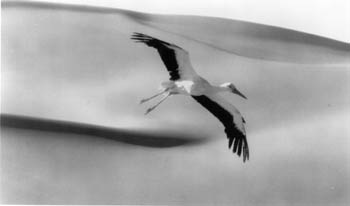![[Metroactive Movies]](/movies/gifs/movies468.gif)
[ Movies Index | Show Times | Silicon Valley | Metroactive Home | Archives ]

Photograph by Renan Marzin Sight for Soar Eyes: A white stork glides over the dunes in 'Winged Migration.' Spring & Fall Bird master David Allen Sibley finally finds his way to hit nature documentary 'Winged Migration'
Writer David Templeton takes interesting people to interesting movies in his ongoing quest for the ultimate postfilm conversation. This is not a review; rather, it's a freewheeling, tangential discussion of life, alternative ideas, and popular culture. I'VE BEEN anxious to see this movie for a long time," murmurs David Allen Sibley. "Way back in March, I began to hear about it at bird festivals and throughout the birding community, where the movie has caused quite a stir. Everywhere I've gone in the last three weeks, someone has said to me, 'Have you seen this amazing movie?' Well, now he can say that he has. The movie--Winged Migration, the nonlinear, Oscar-nominated pseudodocumentary by Jacques Perrin that has turned out to be an art-house hit--tells the story of several dozen death-defying bird migrations, as Perrin's camera follow flocks of pelicans, ducks, geese, European white storks, black-necked swans and others flying thousands of miles over mountains, across deserts and oceans, through storms and fog and the occasional hail of gunfire, in the twice-yearly migrations that crisscross the continents. David Allen Sibley, Massachusetts-based artist and naturalist--one who's done a bit of his own continental crisscrossing over the last few years--is the bestselling author of the Sibley bird guides (Knopf), including The Sibley Guide to Birds, The Sibley Guide to Bird Life & Behavior and the recent Sibley's Birding Basics. The books are fully illustrated with Sibley's exquisite hand-drawn sketches and paintings. Crammed with bird facts and bird-identification hints, the guides have, since their introduction in 2000, become the birder's bible among devoted bird-watchers. It is those same ardent bird-watchers who've been waiting to hear what Sibley has to say about Winged Migration. "I can see why this movie has been inspiring so many people. It's wonderful," he says, choosing his words slowly and carefully, his voice a semidreamy blend of soft-spoken tones and measured amusement. "Some of the scenes," he goes on, "like the barnacle geese flying over the ocean heading for Greenland, are just amazing. I found myself sitting there with my spine tingling, watching these geese flying over this icy ocean. In that one single image, you get a sense of the incredible effort these birds put themselves through in the course of their migrations." "Watching them work so hard to get where they're going," I mention, "I vowed to never complain again about going to work." "I know what you mean," Sibley replies. "One of the things that impressed me the most about the movie was seeing how hard these birds work. The view of the birds, from up inside the flock as they fly, looking at them up close, you really see how the birds are pumping their wings and panting, and to know that they do that for eight or 10 or 12 hours a day, and that some birds that fly over water do it for 72 hours straight, it's just amazing that they can sustain that kind of effort. "There were times during the movie when I wanted to pull out my pocket notebook and take a few notes," he adds, laughing softly. "I was seeing details of the bird's shapes and color patterns that I'd never noticed before." "What moved you the most?" I ask. "I've always been fascinated by migration," Sibley responds. "To me, there is nothing better or more exciting than being outdoors and seeing a flock of migrating birds. It transports you to a place without time, knowing that this migration has been going on, spring and fall, for tens of thousands of years, and to see it happening right there above your head. "To see that," he continues, "is a moment of pure escape from the world. There are quite a few places in this movie that made me feel that way--the barnacle geese flying across the ocean, the bar-headed geese fighting their way through the blizzard in the Himalalayas. These epic migrations of birds give you a sense of the globe as a natural place. In that way, I think the movie was remarkably powerful. "I think that one of the things the movie conveys pretty well," Sibley says, hitting his stride now, "is the sense of a delicate balance. These birds are fighting a life-and-death struggle as they migrate twice a year, and small changes, even things that might seem insignificant--a fishing net lying across a pond, a little bit of oil leaking out of an industrial plant--those things can make a life-or-death difference for an individual bird and, cumulatively, can make a difference for a whole species." Says Sibley, "The effort that these birds put into their migrations and the hazards that they face along the way make for a very tenuous existence. I think that the more people understand that, the more people will understand how our own actions, and our own care of the environment, really do make a difference."
Winged Migration continues its run at the Camera 7 in Campbell and the Aquarius in Palo Alto.
Send a letter to the editor about this story to letters@metronews.com. [ Silicon Valley | Metroactive Home | Archives ]
|
From the July 10-16, 2003 issue of Metro, Silicon Valley's Weekly Newspaper.
Copyright © Metro Publishing Inc. Metroactive is affiliated with the Boulevards Network.
For more information about the San Jose/Silicon Valley area, visit sanjose.com.